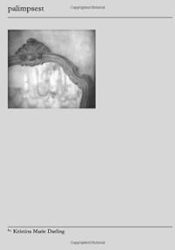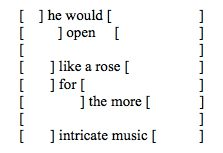
Kristina Marie Darling’s collection Palimpsest opens with a poem by H.D. which ends “before I am lost, / hell must open like a red rose / for the dead to pass.” Darling frequently centers her collections upon the work of others, most notably with her collections The Moon and Other Inventions: Poems after Joseph Cornell and Petrarchan. While these two collections orbit heavily around the art of others, nearly all of Darling’s work feels like a response evoked from the passionate callings of her poetic and artistic ancestors. Darling explained her inspirations in an interview, outlining her intrigue with Marianne Moore’s notion of “conversity,” a term describing the dialogic nature of poetry. “According to Moore,” Darling clarifies, “poetry is a conversation, in which contemporary poets not only respond to what’s been done before, but revise, refine, and perfect it.” It’s easy to see the carefully refined notions of others reflected within Darling’s work, whose lines echo and reverberate like a haunted hallway. As Darling utilizes the familiar clays to mold her startling and evocative poems, they function through a surprising binary of longing, serving as “both grief and homage, reverence and destruction.”
However, no matter how inspired Darling may be, her work never serves as a copy: Darling delights in the formal experimentation within her work. It’s no secret that Darling embraces genres that are difficult to name and categorize, frequently working with bracketed verse, fragments, footnotes, definitions, erasure poems, and diagrams, among others. Darling has outlined these techniques by exploring women’s place in poetry where they are often “othered.” She states: “I believe this is because women refuse to write in a tradition that’s hostile to them, and almost always, this means eschewing predominantly male literary forms.” Undoubtedly, Darling blazes her own trail with her playful variations of richly crafted forms. Take, for instance, her use of bracketed verse:

Here, the brackets can serve several functions: a holding space for missing text or large breathes between words that cause the reader to pause, amping up the passion and mystique. Most noticeably, these lines echo the sentiments laid out by H.D. in the beginning of the book. When read together, the man takes the place of hell, and the music stands in for the dead. Here, we feel the gravitational downward thrust of grief in the workings of nostalgic memory. In another section, Darling erases prose poems that she wrote in her first section, and embraces the use of strikethrough:
beloved
diagrams, devices
they guessedwould kill her.
The strikethrough works to comment on the others around the female figure within the poems and their misinterpretations of her livelihood: in striking out the “they guessed,” the poem makes clear that the female figure is destroyed by the logic and the figures that enclose her peripheries.
Another tactic that allows Darling to stand out as an original from the predecessors that inspire her is her use of surprising metaphors rich with layered meanings. In “A History of Transcendence: A Glossary of Terms,” Darling defines many of her recurring images:
bird. A metaphor for the more ethereal qualities of the heart. Its dark blue feathers were found scattered beneath the trellis after her beloved’s elaborate funeral.
ghost. As in the shadow of a bird, which appeared in an unlit window. She could hear its gauzy wings beating above a box of red geraniums.
Here, Darling manages to touch upon notions of romance through surreal and devastating imagery. If the bird embodies the celestial workings of the heart, its shed feathers are tragically disconcerting. And if the ghost is the figure of a dead bird whose desperate wings echo over nature, this also speaks to the perseverance of love and growth despite the loss of the beloved.
Another interesting genre bender of this collection resides within Darling’s integration of haunting illustrations. In one section, two swans peacefully meander across a field with the backdrop of a large tree. They tower over a couple of baby swans at their feet. Below this image, Darling writes:
2. Within these travel books she found tattered maps and souvenirs. It was then she imagined her heart as a white bird in a silver cage.
The juxtaposition of these lines alongside the image alters the meaning of both the lines and the photo. If the woman referenced sees herself as a bird in a cage, then the picture above it represents a longing for freedom and a rejection of solitude. The swans in the picture roam freely within nature, but they are not in their natural habitat of water—no matter how peaceful they look. Nonetheless, they nurture their brood despite this, while the speaker feels that she has no place to go in her grief, except to stay trapped inward within her own heart.
Palimpsest is a rapturous collection with a lucid vision. As Darling explores her tropes of lilies, photos, cuff links, birds, ghosts, and mercury, readers will find themselves thrilled with the multiple meanings and layers within this richly evocative work that cunningly examines the intricacies and mysteries of the haunted human heart.




